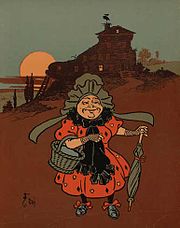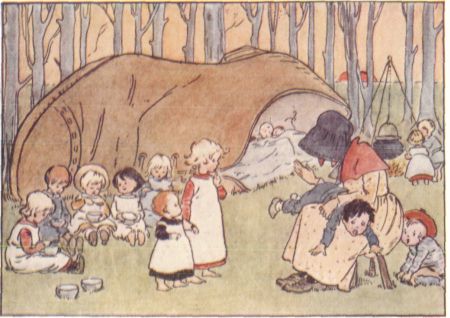There was an old woman who lived in a shoe,
She had so many children she didn't know what to do!
So she gave them some broth without any bread,
And she whipped them all soundly and sent them to bed!
At first glance this would appear to be a purely nonsense
rhyme but in fact it has origins in history! There are numerous choices of
origin.
Debates over the meaning of the rhyme largely revolve around
matching the old woman with historical figures, as Peter Opie observed 'for
little reason other than the size of their families'.
One idea is believed that the character was based on Queen
Caroline, the wife of Great Britain’s George II, who had eight children by him,
seven of whom lived. George III, who was king after him, was actually his
grandson, because his eldest son, Frederick, died before inheriting the throne,
but had already had children of his own, so they became the direct heirs (George
III) instead of George II's other children. The shoe refers to the British
Isles.
Another version is thought to possibly be Mother Goose
herself who they claim was Elizabeth Goose, or Vergoose, of colonial Boston. She
had 6 children from her first husband, and, after he died, had four more with a
second husband. At that time, she was getting pretty old, and it was hard for
her to keep up with 10 children. She literally “Had so many children, she
didn't know what to do.” The boot was the country she lived in.
 Was the "old woman" actually a "he?" King
George III (1738-1820) ascended to the British throne in 1760. From almost the
start of his reign, Parliament and the common people developed a love-hate
relationship with him that lasted until he essentially lost his power in 1810
-- due in large part to mental illness.
Was the "old woman" actually a "he?" King
George III (1738-1820) ascended to the British throne in 1760. From almost the
start of his reign, Parliament and the common people developed a love-hate
relationship with him that lasted until he essentially lost his power in 1810
-- due in large part to mental illness.
During the most strained periods of this relationship, King
George who began the men's fashion for wearing white powdered wigs, was
consequently referred to as the old woman! Supporters of “George III as the old
woman” contend that the “shoe” represents Great Britain, the “children” are
Parliament members, and the “bed” is a symbol for the houses of Parliament which
he required them to have sessions in. Some think that the names “Broth” and
“Bread” referred to actual personages — perhaps a prime minister or two. They
also point out that even today the “whip” is a term used both in the English Parliament
and the American Congress to describe a member whose job is to ensure that
members 'toe the party line'. As a point of historical interest the wigs worn
by women of the period were so large and unhygienic that it became necessary to
include mousetraps in their construction
Another thought along the same lines is the “old woman” was the
English Parliament, who looked after her many colonial “children” in the
far-flung British Empire. Parliament whipped her misbehaving children by
appointing the much-hated James I to the throne in the 17th Century. The
earliest printed version in Joseph Ritson's Gammer Gurton's Garland in 1794 has
the coarser last line:
She whipp'd all
their bums, and sent them to bed.
Even though James is bad-mouthed in this rhyme, he wasn't
all bad.
 Still another thought is that it is based upon a late 18th
Century eccentric one parent family in France, steered at the helm by Margery
Buttwhistle, a known village drunk and prostitute. Ms. Buttwhistle is believed to have had in excess of 20
illegitimate children (fathered during her financially-focused liaisons) and
was unable and/or unwilling to bring them up in accordance with period mores. Vainly vying for their callous mother's attention, the
children formed the notorious “Shoe Gang” which specifically targeted wealthy
aristocrats in exile from revolution-torn Paris. They were so-named due to
their targeting of their victims' footwear. Once thieved, these trophies were presented to Ms.
Buttwhistle, who would barter them in exchange for mead. The incredulous local
inn keeper who accepted this payment in kind stored the contraband in the
cellar until it could be surreptitiously shipped up to Bristol by clipper. Because of her daily inebriated state, Buttwhistle would
seldom leave the bar of a night, managing only to collapse in the cellar and
sleep off her drunken excesses; with only the shoes for company.
Still another thought is that it is based upon a late 18th
Century eccentric one parent family in France, steered at the helm by Margery
Buttwhistle, a known village drunk and prostitute. Ms. Buttwhistle is believed to have had in excess of 20
illegitimate children (fathered during her financially-focused liaisons) and
was unable and/or unwilling to bring them up in accordance with period mores. Vainly vying for their callous mother's attention, the
children formed the notorious “Shoe Gang” which specifically targeted wealthy
aristocrats in exile from revolution-torn Paris. They were so-named due to
their targeting of their victims' footwear. Once thieved, these trophies were presented to Ms.
Buttwhistle, who would barter them in exchange for mead. The incredulous local
inn keeper who accepted this payment in kind stored the contraband in the
cellar until it could be surreptitiously shipped up to Bristol by clipper. Because of her daily inebriated state, Buttwhistle would
seldom leave the bar of a night, managing only to collapse in the cellar and
sleep off her drunken excesses; with only the shoes for company.
Iona and Peter Opie pointed to the version published in
Infant Institutes in 1797, which finished with the lines:
Then out went th'
old woman to bespeak 'em a coffin,
And when she came
back, she found 'em all a-loffeing.
The term "a-loffeing", they believed, was
Shakespearean, suggesting that the rhyme is considerably older than the first
printed versions. They then speculated that if this were true it might have a
folk lore meaning and pointed to the connection between shoes and marriage,
symbolised by casting a shoe when a bride leaves for her honeymoon. This later became
the tossing of the bride’s bouquet, and the thought that the woman who caught
it would be the next to marry.
One really is wondering why we teach our children some of theses nursery rhymes! But they are a loved memory of my childhood.


Thank you for such an interesting an informative post. I never knew there were so many possibilities for the origin of this rhyme.
ReplyDeleteI must say I like your line: 'financiallly-focused liasons'. A very delicate way to describe it. :)
Of course!! One has to remember in the days of such vocations one was very careful of ones wording so as to not be looked down upon if one should use a coarse way to describe it.
ReplyDeleteAll done tongue in cheek mind you!
This comment has been removed by a blog administrator.
ReplyDelete